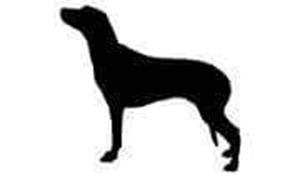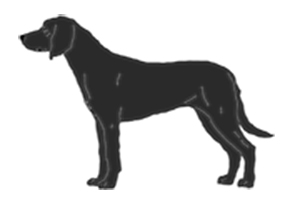Recently, online bullying has become a hot-button issue for children and teenagers. However, online bullying happens to adults, by adults. Bullying happens within the dog show world as well. As with any competitive sport, tensions run high and it tends to draw those with a competitive spirit. Some people can take things too far, especially in dog shows because it is one of the few sports where professionals and novices compete against each other on an equal playing field. When I first started showing dogs in 1998 as a precocious youngster with Westminster dreams, bullying was the furthest from my mind. To be able to compete against my heroes in Beagles was a dream come true and I still view it like that. When I showed Beagles, I never dealt with bullying mainly because there seems to be an unspoken rule in that adults never bully a child.
I showed in Junior Showmanship as a teenager with my mentor's Great Danes. I never dealt with bullying then, when you would think that it would happen with competitive teenagers competing against each other. Sure, I saw dirty tactics like trying to close in on me, other handlers intentionally stepping forward or stacking their dogs in a way to block the judge's view. However, that is all part of being competitive in my mind. Is it dirty? Sure it is, and it can be a sign of poor sportsmanship. When I showed semi-professionally, I never dealt with bullying either. I think it was because I was still very young and it showed. I still had this juvenile look about me in my late teens and early twenties that seemed to be an armor against that.
The bullying to me started when I got my first Hamiltonstovare, Alice, and started winning. Unlike most, my bully was the very person who should be the last person to bully me, my dog's breeder. Her tactics started out subtly by trying to take credit for a win or in some cases a title. It would be harmless statements like “My Alice won a group today” or “My Alice got her Championship” within Facebook, with no reference to me or that I did anything to guide Alice to those wins. I started to subtly fight back by commenting that I handled Alice and that Alice lived with me.
Things got worse when I got Rolo. Rolo was highly admired by a person in Australia. This person was nice and rarely said anything to me prior to me getting Rolo. When I got Rolo, this person commented on nearly everything I did on Facebook. This person lulled me into a sense of false security and even tried to convince me to allow her to get an Alice puppy when Alice was bred. I was very vague regarding Alice's litter as Alice's breeder kept on trying to lead me on and make me believe that I had some sense of control with Alice's reproductive life. Plus, I had doubts that Alice would ever be bred because of her erratic heat cycles. As with any serious puppy inquiry, I did my due diligence and gave her a quote for import costs and consulted with her town council regarding her eligibility to obtain another dog. I have a friend who is now a vet in Australia and she went through a struggle when she was younger to obtain another dog as Australia has very strict dog ownership laws. I remembered that and made sure to follow through. I informed the person of the quote and asked her if she had clearance to violate the dog limit. I never got an answer and I refused her request to get an Alice puppy. At that point, things changed dramatically between her, my dogs' breeder and myself. My dogs' breeder was already distant to begin with in regards to giving me information and paperwork, let alone communicating with me. After that, it was next to impossible.
Things ramped up when Alice's litter was born. Alice and Rolo's breeder was very silent, the Australian woman was not however, and she brought another Australian Hamiltonstovare owner/breeder this time. I naively bought a puppycam and allowed public viewing prior to the puppies' birth. Those people decided that it would be a prime opportunity to view the camera and message me. At first they seemed concerned and when I assured them that Alice's best interests were at heart or when I cut off the camera during her emergency c-section, things died down. Then when I cut the camera on, things changed, badly. When it appeared that Alice and her puppies would live they took every chance they could to privately and publicly harass me. To anybody who has bred a litter that had complications, it is a stressful time. I kept Alice and her puppies as priority from day 1. As somebody who has had a surgery before (recently multiple), keeping the incision clean and free from debris is priority and comfort is secondary. As such, I made the decision for the first few days while Alice was nursing to have Alice nurse on highly absorbent surgical pads and cloths. The Australians as I began to call them, thought that it was cruel and took the time to bash me publicly on Facebook saying that Alice was dying, suffering and in pain. Their evidence was the “gross bits of paper” they saw in the whelping box. So let me set the record straight, NEVER was Alice on soiled surgical pads or cloths for long. I did this at the advice and recommendation of Alice's reproductive specialist who is highly respected in this area. Thanks to that care, Alice recovered quickly and no scarring from the c-section. After her sutures came out, she was on comfortable bedding.
After that public bullying and harassment, I blocked both of them. However, I did keep screenshots and evidence of what they said, that included comments hoping for Alice's death, the death of her puppies and that I would “permanently go away so the breed isn't harmed”. I also noticed that Alice and Rolo's breeder supported the public bullying and harassment by “liking” their posts. So, after just 2 days, I was forced to make the puppcam completely private to everyone, including the future puppy owners (who had every right to view it but was denied that chance thanks to those horribly spiteful people). Thankfully, things died down and I was able to enjoy the puppies and help raise them in a manner that I approved of, with attention and love.
As the puppies grew, I started to notice some strange comments from a few that support Alice and Rolo's breeder. Those comments seemed to be overly critical of how the puppies were being raised. Finally one couple decided to send me a private message that said that they hoped that Raven would die so it would “teach me a lesson”. That couple was blocked and reported.
Again things got quiet, until I decided to start a blog on this site. My decision to start a blog was because of my desire to clear my name in certain circles and give my full and complete side of the story. At the advise of my attorney, I have and will continue to keep names out of it. Even though I have evidence of the harassment and bullying, I wish to protect myself. I posted Alice and Rolo's stories and never heard anything. Then I decided to post a harmless post regarding Popular Sire Syndrome and once more things changed again. I briefly mentioned that epilepsy is in the breed, specifically in Australia. That fact is true, yet again I have a screenshot from the owner who describes their dog's diagnosis as epilepsy, publicly. The Australians planned a coordinated attack while I was at this year's Westminster Kennel Club dog show, participating in Meet the Breeds and educating the public about the Hamiltonstovare. They posted on the group “Hamiltonstovare Dog Lovers” a grossly false post about me. I went to the admin of that group who instead of removing the harassers, they blocked me and my fiance from the group. The admin of that group then proceeded to belittle me and what happened to me, she then belittled my very real diagnosis of PTSD and what that does to a person. No group admin should EVER belittle a person with a legitimate issue, especially if they mention that the behavior of these individuals were actively triggering a person's disability. Thanks to what happened, I had multiple panic attacks while I was at Westminster, in NYC and on my way home. That group is a hotbed of Hamiltonstovare gossip across the board and I am actually glad to be away from the drama. The harassment did not stop at the Facebook group, they tried to flood my private inbox with emails, they also falsified a contact form and posed as an American. They then tried to comment on multiple blog posts.
This page is supported by and created using squarespace. Squarespace is a lovely service that allows me to see IP addresses, the country of origin and the website that they viewed to access my site. I know that this was a coordinated attack against me because IP addresses from 2 locations in the UK (one from the couple I blocked and one from Alice and Rolo's breeder) and 2 locations from Australia weeks prior to Westminster and on the day(s) of the attack. It also showed that these people used private Facebook messenger to send my website link back and forth to each other. To this day at least one of those IP addresses has been monitoring my site on a weekly and sometime daily basis. Also, any comments to my blog must be approved prior to them being posted, so I have screenshots of that. I also have screenshots and emails (which falsifying emails is classified as a federal crime in the US) of what was sent to me. With that, I went to the US authorities, UK authorities and the Australian government. The Australian government has an online harassment and bullying special unit and they are monitoring those that I reported if anything happens further.
Every one of those people were members of the Hamiltonstovare Club of America and since this is a parent club that is regulated by the American Kennel Club and its bylaws, those members were removed and reported to their local kennel clubs.
I have decided to make this post after I read a blog post from a person that I admire within the dog world. My bullying story is in no way unique in the dog world. The sport of purebred dogs is declining fast and this behavior from grown adults has to stop. If we want the next generation to be able to enjoy purebred dogs on any level, we have to be accepting and decent people. We have to encourage and promote our Junior Handlers, novice handlers, novice breeders, etc. I honestly believe that is why the United Kennel Club is growing by leaps and bounds yearly, because it is the most welcoming dog registry I have ever seen. The drama that I have seen in the UKC is from petty people and those people generally don't stay around UKC events very long.
So every person who has been involved in the sport of dogs in any outlet, be nice to each other, help out new people, be nice to spectators, and always encourage the next generation of our wonderful sport.












